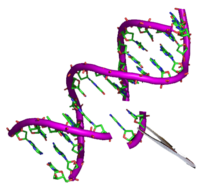
Photo from wikipedia
Polyamines are small polycations derived from arginine and/or ornithine. These compounds are present in all living organisms and play common and organism-specific functions. Polyamines are present in most food products… Click to show full abstract
Polyamines are small polycations derived from arginine and/or ornithine. These compounds are present in all living organisms and play common and organism-specific functions. Polyamines are present in most food products of plant and animal origin, thus having an impact on human nutrition and health. In this Topic, we aimed to cover both basic and applied research on polyamines in the areas of plant biotechnology, food nutrition, and human health. In plants, the most abundant polyamines are putrescine (Put), spermidine (Spd), and spermine (Spm). The control of polyamine levels is achieved through regulation of their biosynthesis, catabolism, and transport, which are modulated by the environment. Past and current research on polyamines has investigated basic processes of polyamine homeostasis, as a mean to obtain crops better adapted to climate change. The discovery of polyamine signaling pathways will also help in reaching this major goal. In this Topic, Zhao et al. report on the characterization of the Ornithine decarboxylase (ODC) enzyme from Hyosciamus niger, involved in Put biosynthesis. The ODC enzyme exhibits higher catalytic efficiency than other plant ODCs reported so far, thus providing an ideal candidate gene for polyamine biosynthesis engineering. Sekula and Dauter report on the crystal structure of Agmatine iminohydrolase involved in Put biosynthesis from arginine and identify that the dimeric assembly of monomers is drastically different from the bacterial enzyme. The same authors also obtained crystals of spermidine synthase, involved in Spd formation, and characterized the structures of the two dimeric enzyme isoforms in Arabidopsis (Sekula and Dauter). Plants also contain thermospermine (tSpm), a less abundant but very relevant polyamine synthesized from Spd by thermospermine syntase (tSPM), in a reaction that is conserved throughout the plant kingdom (Solé-Gil et al.). According to these authors, tSPM might play developmental and/or stress-related roles in addition to the confirmed function in regulating xylem cells maturation, in both non-vascular and vascular plants. Ishitsuka et al. have shown that the response to tSpm is conserved in dicots and monocots and plays a role in translational enhancement that could be eventually applied as a biotechnological tool in animal and fungal systems. The work by Zarza et al. shows that Spm triggers a quick phosphatidic acid response in Arabidopsis, which is mainly mediated by phospholipase D. Their results suggest the participation of phosphatidic acid in Spm perception.
Journal Title: Frontiers in Plant Science
Year Published: 2020
Link to full text (if available)
Share on Social Media: Sign Up to like & get
recommendations!